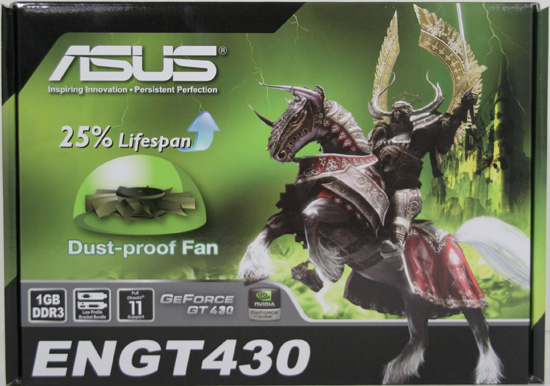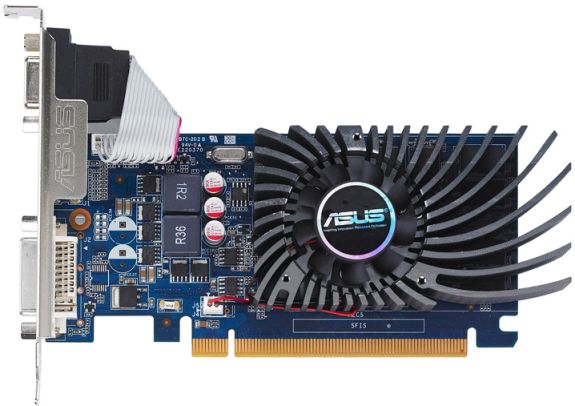NVIDIA's GeForce GT 430: The Next HTPC King?
by Ryan Smith & Ganesh T S on October 11, 2010 9:00 AM ESTMeet the Asus ENGT430
For our look today at the GT 430, Asus graciously provided us with their GT 430 card, the ENGT430. As with all the other cards being released it’s a custom design, featuring the usual Asus design elements: a double-sealed fan, fuse protection, and - while we have a hard time believing this is an issue on such a small card – GPU guard PCB reinforcement.
For this card Asus is very specifically going after the HTPC market. The ENGT430 is a half-height card with a low-profile bracket included, and for cooling it uses a decently sized heatsink with a particularly tiny fan we measure at 36mm. The heatsink does stick up some, so the card is explicitly a double-slot card and you’ll want to make sure you have space for it.
As is the case with low-end cards, reference clocks don’t tend to mean much. While the GT 430 has a reference speed of 700MHz for the core and 1.8GHz effective for the DDR3 memory, Asus has gone ahead and clocked the card at 1.6GHz for the memory. The card is equipped with 8 800MHz (1.6GHz effective) Hynix DDR3 memory modules running in 16bit mode, which is why the card is clocked below NVIDIA’s reference clocks. We expect to see memory clocks all over the place with the launch cards, depending particularly on who could get the best deal on what speed grade of DDR3 RAM for these cards. Given that GT 430 is likely already a memory bandwidth challenged card, this will have an impact, although we don’t have the means to measure it (our card would only go to 1.75GHz on the RAM).

For ports Asus is going with what’s undoubtedly going to be the universal configuration for low-profile GT430 cards: 1x DVI, 1x HDMI, and 1 VGA port. The DVI port is necessary for monitors (without resorting to a dongle), the HDMI port is necessary for HTPC roles, and the VGA port being an easy addition as an optional 3rd port due to its analog nature. GF108 can only drive 2 monitors at once, so the usual restrictions apply.
As is common for budget cards, there’s little else besides the card in the box. Asus includes the low-profile bracket, a multilingual quick installation guide, and a driver CD. This is the first Asus card we’ve reviewed for some time without voltage tweaking capabilities, so even NVIDIA’s integrated overclocking utility is enough for the task.












120 Comments
View All Comments
n9ntje - Monday, October 11, 2010 - link
Sad to see Nvidia doesn't live up to expectations, while they want us to believe that they have a perfect HTPC card, it isn't.To most people, image quality counts. 3D is still a niche.
IceDread - Monday, October 11, 2010 - link
Yeap, it's always best if the competition is even, gives us the best prices.medi01 - Monday, October 11, 2010 - link
I am afraid market is too slow to react to nVidia having worse products, AMD has nowhere near market share that it deserves to have.We can't expect one player to dominate all the time. So when the underdog creates superior products, it should benefit from it. But this is not the case in GPU market, unfortunatelly, as nVidia still keeps much bigger market share, than AMD.
dnd728 - Monday, October 11, 2010 - link
I've tried quite a few ATI/AMD cards over the years, including the latest 5000 series, and to date not a single one of them worked right, i.e. without keep crashing Windows.It could be one reason.
electroju - Monday, October 11, 2010 - link
I agree and I have also used ATI and AMD graphics over the years. AMD graphics writes the worst software or drivers from a reputable company. I go with nVidia because I care for reliability and stability. I do not mind spending money on nVidia graphics because the money goes towards software development. The cost of AMD graphics is too low to provide enough for software development.Zoomer - Monday, October 11, 2010 - link
I have personally found nvidia cards to have inferior hardware quality. This was very evident from the time when quality dacs for vga mattered, and nvidia cards absolutely sucked at that. Further suboptimal decisions made their cards meh.Software wise, I thought nvidia's software quality peaked around the time of the detonators.
AmdInside - Monday, October 11, 2010 - link
DACs depended on the maker of the card. Quadro NVS cards which were made by NVIDIA were regarding as having excellent 2D image quality over analog display. Sadly a lot of NVIDIA partners used cheap DACs on some of their cards.mentatstrategy - Wednesday, October 13, 2010 - link
Nvidia Fanboi: I have used ati cards and they suck!ATI Fanboi: I have used nvidia cards and they suck!
heflys - Monday, October 11, 2010 - link
Hmmm....Haven't had a problem with ATi/AMD drivers thus far.duploxxx - Friday, October 15, 2010 - link
perhaps you need to read a bit more and see how many 1000's have been recently been affected by this awesome nvidia reliability and stability when they all had to throw away there graphic cards and laptops.